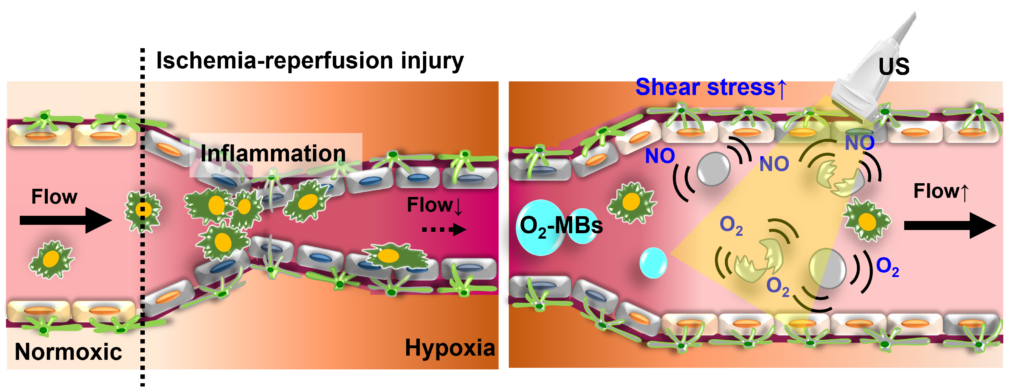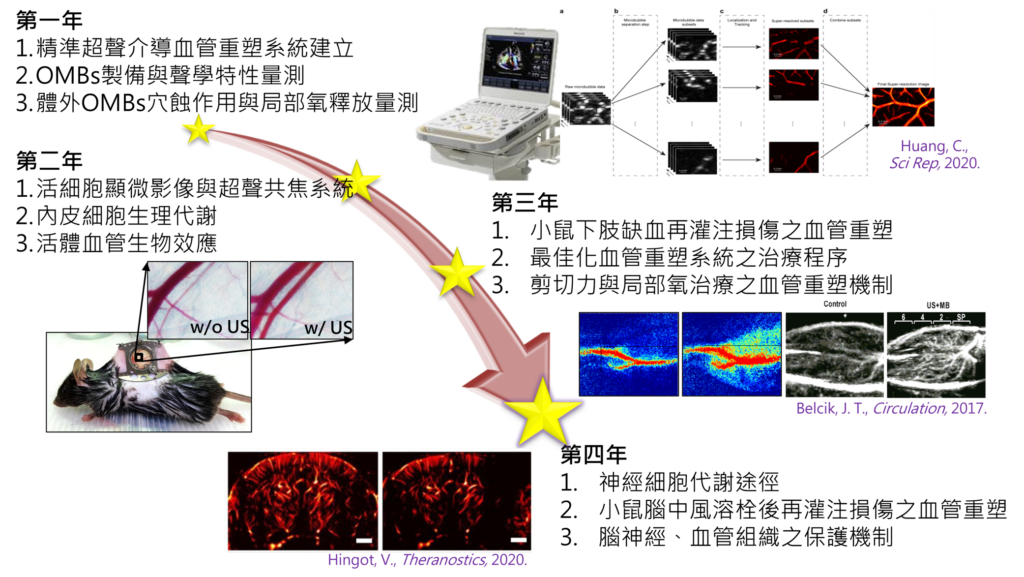
建立精準超聲介導血管重塑系統:調控缺血再灌注損傷中之內皮代謝和腦中風之神經保護
缺血再灌注損傷為腦中風溶栓、心血管支架置入、器官移植之重大問題。血管經過一段時間的缺血,再度恢復血流灌注後,由於內皮細胞的不正常生理代謝,導致細胞走向凋亡使血管組織壞死,雖然醫學研究運用抗氧化劑、血管舒張劑、高壓氧治療等,有效抑制實驗動物的缺血再灌注損傷,但進入臨床試驗後並無顯著的效果。因此,本計畫欲建立精準超聲介導血管重塑系統,結合超解析超音波影像,提供精準血管定位、即時血流、血管內皮剪切力之資訊。以超音波刺激攜帶氧氣的微氣泡,提升剪切力與局部氧治療於受損血管,調控血管內皮細胞之生理代謝,引導受損細胞進行修復,同時誘發血管舒張,避免發炎細胞阻塞形成二次血栓。為驗證此系統於生理機制上的調控與療效,以活細胞顯微系統研究內皮細胞代謝,以活體血管影像評估生物效應與安全性,接著於小鼠下肢缺血再灌注模型上,建立血管重塑之最佳治療程序。為模擬臨床腦中風治療實況,使用小鼠腦中風溶栓之再灌注模型,驗證其治療效果與神經保護機制。本計畫期望此精準超聲介導血管重塑系統,可促進多種組織器官之損傷修復,為臨床研究缺血再灌注損傷,提供嶄新的治療思路。
Development of precise ultrasound-mediated vascular remodeling system: regulating endothelium metabolism in ischemia-reperfusion injury and neuron protection in stroke
Ischemia-reperfusion injury plays a crucial issue in stroke thrombolysis, cardiovascular stenting, and organ transplantation. After a period of ischemia, the reperfusion of fresh blood causes cell apoptosis and vessel injury due to the dysfunctional cell metabolism. Although previous studies presented well treatment outcome of ischemia-reperfusion injury by using antioxidant, vasodilator, and hyperbaric oxygen therapy in animal experiments, there showed no significant efficacy in clinical trials. Thus, our project prepares to develop a precise ultrasound-mediated vascular remodeling system, which integrates super-resolution ultrasound imaging to provide precise locating of injured vessels, real-time blood perfusion tracing, and vascular endothelial shear stress. During ultrasound-mediated oxygen-loaded microbubble cavitation, the enhanced shear stress and local oxygen therapy on the injured vessels might regulate endothelium metabolism for repairing and vasodilation for avoiding secondary thrombus by inflammatory cell accumulation. To proof the biological mechanism could be regulated by a precise ultrasound-mediated vascular remodeling system, the metabolism of endothelial cells and in vivo vascular bioeffect are investigated. The optimal treatment procedure and tissue repairing pathway are determined under the mouse hind-limb ischemia-reperfusion model. For simulating the clinical stroke thrombolysis procedure, the mouse stroke reperfusion model with thrombolysis is built to demonstrate the feasibility of vascular remodeling and neuron protection. Finally, we propose this system might be applied to repair other injured tissue and organs, which provides a proof-of-concept to develop a novel strategy for reducing ischemia-reperfusion injury in clinic.
